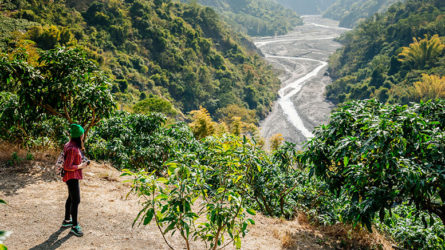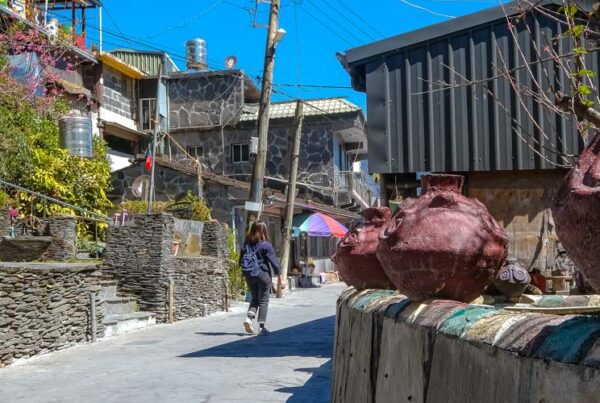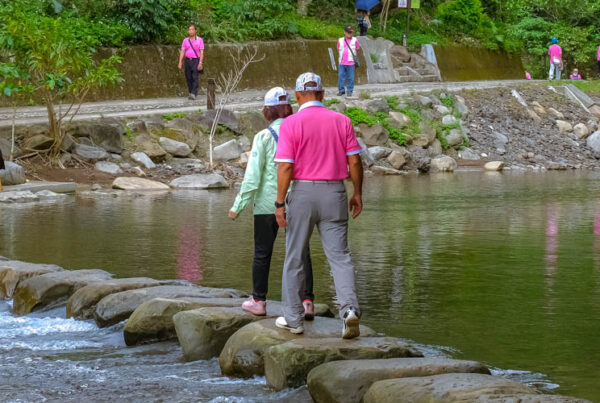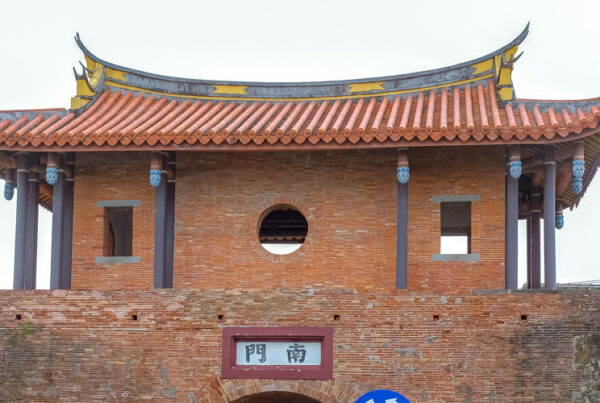Rafting the Laonong River in Southern Taiwan Is Exciting Fun!
The Laonong River in southern Taiwan is one of two major rivers on the island suitable for river-rafting trips, the other being the Xiuguluan River in eastern Taiwan. Rafting on the Laonong is a thrilling ride over muddy-gray waters, with adrenaline-inducing rapids and enchanting mountain scenery along the way.
Text: Joe Henley; Photos: Maggie Song
Among the things in Taiwan you will find in great supply are mountains and rain. Mountains over a thousand meters in elevation account for nearly a third of the land mass of Taiwan proper. The average annual rainfall for the country as a whole weighs in at a sopping-wet 2,500 millimeters. When you combine high mountains with abundant rainfall, what do you get? Rivers flush with rapids and dreams come true for whitewater-rafting enthusiasts.
There are two ways whitewater rafting in Taiwan can be experienced – with a paddle in your hands or without. The former requires a bit more training and instruction before you can hit the river, of course, and grants you at least a modicum of control over the direction of the inflatable craft you are sitting in, novice paddling skills notwithstanding. Near the town of Ruisui in Hualien County, in Taiwan’s east-coast region, outfitters take paddle-bearing fun-seekers of all skill levels on the Xiuguluan River for excursions that last three to four hours. The trips cover over 20 kilometers and you pass over 20 sets of rapids along the way. It’s a challenge, and an exhilarating one, providing the chance to work together with friends and strangers – an excellent team-building exercise, adrenaline-rush experience, and bonding session all rolled into one.

Rafting on the Xiuguluan River in Hualien
To take on roaring currents without paddle, head for the mountainous Liugui District in the sprawling expanse that is south Taiwan’s Kaohsiung City. The Laonong River runs through the district north to south. The scenery here is stunning, with the 18 Arhats Mountains (named for the Mahayana Buddhist tale of the 18 original followers of the Buddha) to the west of the river providing views of tightly grouped, densely forested peaks that, in fact, number more than 40.

The 18 Arhats Mountains west of the Laonong
The river, the source of which is found on the east side of Yushan (Mt. Jade), Taiwan’s highest mountain, has seen hard times in recent years. In 2009 Typhoon Morakot ravaged southern Taiwan, the deadliest storm to hit the island in recorded history. By the time it moved on, nearly 700 people had perished, and over US$3 billion in damages had been suffered. The Laonong, a favorite spot for whitewater rafting since the mid-1980s, was also drastically affected. It took years to restore the roads in Liugui and repair the damage done to the riverbed by the raging floodwaters, and it was only in June 2016 that area rafting operators were given the all-clear to resume their business.
One of those outfitters now back in business is Heroes Rafting, which has been taking thrill-seekers down the Laonong since 2000. According to the business manager, Mr. Hu Jun-xiang, the Laonong River ranks a four on the International Scale of River Difficulty, out of a possible six. For those not versed in the intricacies of the ranking system, a Class I means “Very small rough areas, requires no maneuvering,” with virtually no skill required whatsoever. A Class IV, however, means “Whitewater, large waves, long rapids, rocks, maybe a considerable drop, sharp maneuvers may be needed.” For this, advanced whitewater experience is recommended.
Recently I headed down to Liugui with a few friends to take to the waters of the Laonong. After arriving at the Heroes Rafting facility, Mr. Hu assured us that the river is suitable for rafters “…of all experience levels, even those who can’t swim.” Remembering a trip on the Xiuguluan, which ranks about a three on the scale, I recalled some fairly intense stretches on that river, making me wonder how thrilling my upcoming ride would be. Before we went to the river, we watched an instruction video and learned what to do in case someone went overboard (pull on the life jacket, not the extremities of the person in the water!), and I just hoped I wouldn’t be the one dunked into the chalky folds of the gray, sediment-laden water.
Following this seven-minute video crash course, I and the rest of our group, a crew of about a dozen altogether, were taken to the outfitting area to get our life jackets and helmets. The guides demonstrated how to put everything on the right way, and provided further instruction on the various things to do and not to do while out on the water (do hold on to the dual safety ropes at all times, and don’t ever get out of the boat!).

Putting on life vests before the rafting
Finally, it was time to head to the water. We got into a pair of passenger vans for the short drive to the river’s edge. On the bank, the guides showed us how to properly straddle the sides of the inflatable and grasp the safety lines. My eyes kept wandering to our starting point, to my inexperienced eyes a rather gnarly section of rapids alive with frothing whitecaps and surging swells.

Safety instructions on the river bank
A pair of smaller motorized chase boats stood at the ready, tasked with following us down the river to nudge us along the safest path or assist us if we ever became grounded in the shallows stranded on exposed rock. We were told that if we heard someone yell out “jiao!” (“legs!”), it meant we were to tuck our outside leg up onto the edge of the craft while the chase boat bumped us back to a safer path.

On the muddy waters of the Laonong River
With all this in mind, we piled in. Getting that first stretch of rapids out of the way almost right away was actually good for the nerves (“if we can get through that, maybe the rest won’t be so bad”). From there the trip was interspersed with periods of calm and carefully controlled and supervised chaos. With the men in the two chase boats keeping a careful watch on our progress, in a light drizzle we passed by some of the Arhats Mountains looming over the green river valley to our right, farmers on the banks stopping their work to watch us float by traversing the undulating sections of whitewater.
True to their word, any time we became stuck or drifted toward a section deemed a bit too lively, we were nudged cautiously towards less tempestuous or deeper, slower waters on the outer portions of the river bends. One of the final sections of rapids necessitated that we lower ourselves down and lean forward in order to traverse a particularly heart-pounding set of declines and inclines over what must have been a massive set of stones somewhere beneath the roiling waters. Of the 12 of us who had set out, only one wound up briefly in the drink, quickly hauled back in unscathed by the others.

The rafting trip takes about one hour
When all was said and done, we had ridden the Laonong for about an hour, covering a distance of around 10 kilometers, enjoying both the moments of laconic serenity during which we could take in the beautiful mountain surroundings and those of bursting excitement when the river boiled around us and waves crashed across bow and stern. Without paddles, there’s little in the way of something to do beyond holding on and appreciating the stimulating emotional rollercoaster. At the end of the ride we were picked up on the riverbank and driven back to the outfitter’s office, where shower facilities allowed us to wash off the gray sediment we’d all collected. Tellingly, everyone was all smiles at the trip’s conclusion.

One of the more turbulent sections of the river
Heroes Rafting operates every day from June through September. From Monday to Friday, the price for a one-hour trip is NT$700 per person, with departures twice a day at 10am and 2pm. Generally, says the staff, the morning weather tends to be more agreeable, and guests should show up one hour before the scheduled departure time for the prep session. On weekends the price jumps slightly to NT$800 per person, and the departure times change to 9:30am and 1pm, respectively. Buses are available from THSR (Taiwan High Speed Rail) Zuoying Station in Kaohsiung’s main urban area to the town of Liugui, and Heroes can pick you up there to take you to its staging grounds.

Laonong River rafting, done!
Note that Meinong, the township next to Liugui to the west, is worth spending some time in as well, especially to see the Meinong Hakka Cultural Museum or the Yuan Xiang Yuan Cultural Village. Just west down Provincial Highway 28 from the latter, where all aspects of the famed traditional oil-paper umbrella art form are on display, is the aptly named Meinong Restaurant, featuring Hakka cuisine such as bantiao (thick, flat) noodles, pork knuckle, and fiery stir-fry in its finest form.

Hakka dishes at at restaurant in Meinong
Add: No. 154, Guangfu Rd., Liugui Dist., Kaohsiung City
(高雄市六龜區光復路154號)
Tel: (07) 689-3555, 689-3111
Website: www.heroes-rafting.com.tw

The MAOLIN National Scenic Area in Southern Taiwan
taiwaneverything.cc/2016/05/15/the-maolin-national-scenic-area-in-southern-taiwan/















